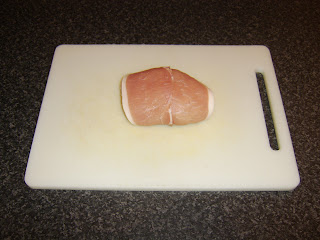It has to be said that cod is one of the very last things I expected to be eating tonight when I set out for the supermarket this afternoon. Why? Not because I don't love cod - I do! The reason why I did not expect to be eating cod is that I went in search of a cheaper, less popular type of fish, which I intended cooking, eating and publishing here in support of, "The Big Fish Fight," the fish conservation campaign newly featured towards the top of the right hand column of this blog, which is presently garnering a great deal of support here in the UK. I was amazed by what I discovered...
The image above shows a fillet of cod, more than a pound in weight, selling for
considerably less than the price I would have expected to pay for it! The supermarket was sold out of
coley, the fish I had most particularly gone in search of to cook tonight. I further discovered that the coley - while in stock - had been selling at a
higher price than the cod. That must be a historical first. I can only assume that this is an economic knock-on from the campaign, affecting the price of fish at market. Fingers crossed it is a temporary issue and does not cause fish markets and the daily bidding to degenerate in to chaos, fishermen never knowing which catch will fetch the best price...
The recipe, however, is what matters most - on this blog - at this point in time. Needless to say, although my morals were disappointed to have to, "Settle for cod," the rest of me was more than happy to do so. The piece of cod which I purchased will be enough to form two generous portions.
The first step in this recipe is to get the salsa ingredients prepared, mixed together and stuck in the refrigerator for the flavours to have time to infuse.
Salsa Ingredients
1 medium tomato
2" of cucumber
1 clove of garlic
1 red chilli pepper
3 large basil leaves
2 tbsp extra virgin olive oil
1 tsp white wine vinegar
Salt and freshly ground black pepper
Salsa Preparation
The tomato should be halved and the cucumber likewise, straight down through the centre. The seeds of both should be scooped out with a teaspoon before they are finely diced and added to a mixing bowl or basin. The chilli pepper should be finely chopped (seeds in or out, depending upon preference,) the garlic clove peeled and grated and the basil leaves finely chopped. All should be added to the bowl, along with the olive oil and white wine vinegar. Season, stir well and cover with clingfilm. The salsa can now be refrigerated until the remainder of the meal is ready to serve.
I have prepared my chips as I normally do and have featured the method many times on this blog. In order to avoid excessive repetition, for those who are unfamiliar with my method, full instructions can be found
here.
Note that in order to cook cod (or most types of fish) in this way, it is imperative you buy it with the skin still on. The skin will serve as protection during the intensity of the early cooking process and prevent the flesh from damage. When halving the cod as I have done here, you should cut in to it through the flesh with the skin side down. Trying to cut through the skin first will be likely to have disastrous consequences for the fillet and damage it considerably.
Add a couple of tablespoons of plain (all purpose) flour to a dinner plate, season it with salt and pepper and pat the cod fillet in it on the skin side. Bring some sunflower oil up to a fairly high heat in a non-stick frying pan, pat the excess flour off the cod and place it in to the pan, skin side down. It is at this stage you should begin the final frying of your chips.
The thickness of your cod fillet will determine its cooking time but allow ten minutes. Simply watch it from the side to see when it appears to have cooked three-quarters of the way through. You can determine this by watching the colour turn from transparent and slightly pink to white and opaque. When it has cooked to this extent, turn it over and reduce the heat. Around three minutes should be allowed to complete the cooking process.
In the image at the top of this post, I have served the cod with the skin on and a lemon wedge and basil leaves to garnish. If you prefer, you can very easily remove the skin by gently peeling it away and serve it in the fashion below, along with the chips and salsa. Do, however, give the salsa a taste and adjust the seasoning if required, immediately prior to service.








































